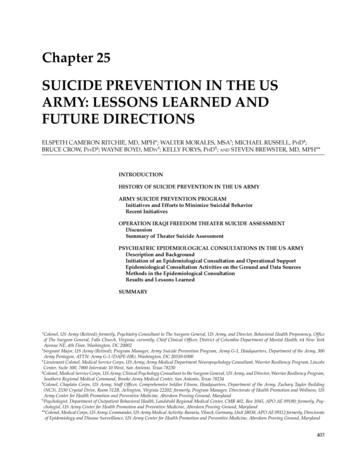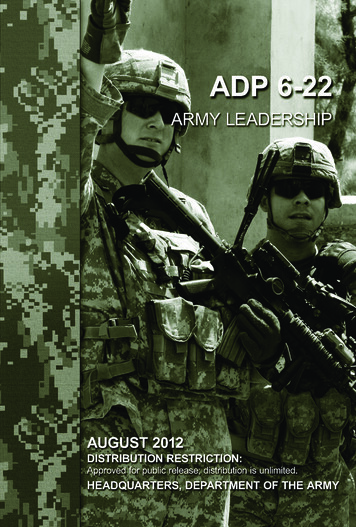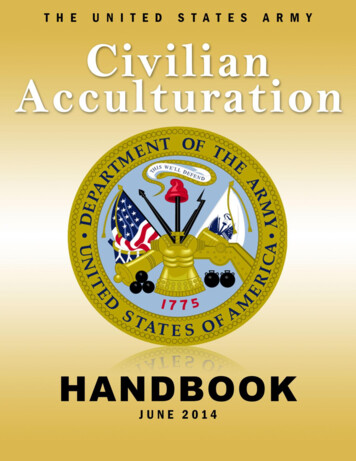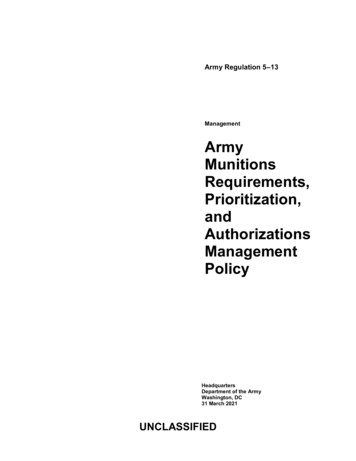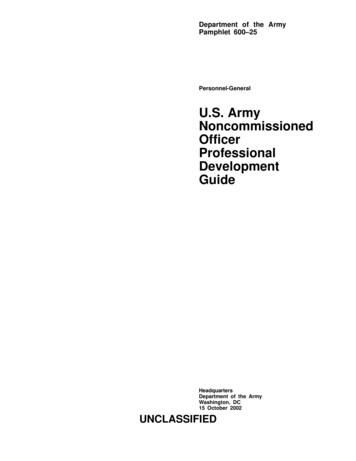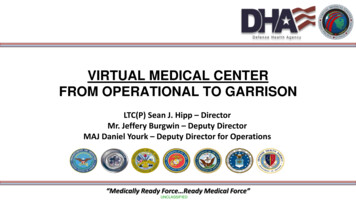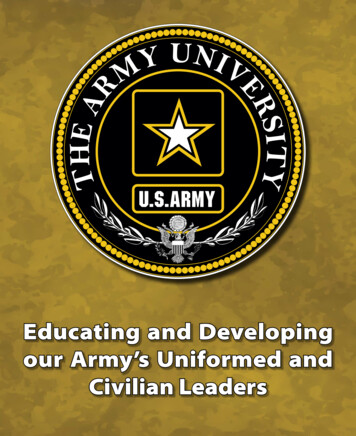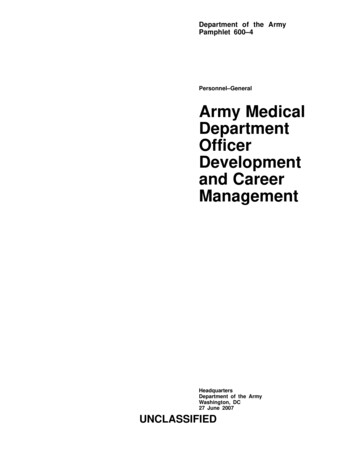
Transcription
Department of the ArmyPamphlet 600–4Personnel–GeneralArmy MedicalDepartmentOfficerDevelopmentand CareerManagementHeadquartersDepartment of the ArmyWashington, DC27 June 2007UNCLASSIFIED
SUMMARY of CHANGEDA PAM 600–4Army Medical Department Officer Development and Career ManagementThis major revision dated 27 June 2007-oIncorporates the Army Values and the Warrior Ethos into officer personnelmanagement (chap 1).oAdds chapter 3, Army Medical Department Officer Career Management.oIntroduces the evolving changes to the Officer Education System (chap 4).oAdds chapter 5, Officer Promotions, identifying current Army promotionpolicies and specific guidelines for Army Medical Department officerpromotions.oAdds chapter 6, Reserve Component Army Medical Department Officer Developmentand Career Management, providing detailed information on Army Reserve andArmy National Guard Army Medical Department officers.oDescribes the Command Selection System process and the evolving changes inmanaging Army Medical Department command selection list command positions(chap 7).oIncludes major revisions to each Army Medical Department Corps chapter, andupdated life cycle models (chaps 8 through 13).oIncludes career development of Army Medical Department warrant officers(chaps 10 and 13).
*Department of the ArmyPamphlet 600–4HeadquartersDepartment of the ArmyWashington, DC27 June 2007Personnel–GeneralArmy Medical Department Officer Development and Career Managementprovides guidance on leader developmentconcepts and responsibilities, informationon opportunities for Army Medical Department command positions, detailed information on development andmanagement of Reserve ComponentArmy Medical Department officers, andoutlines Army promotion policy includingspecial considerations for Army MedicalDepartment officers.Applicability. This pamphlet applies tothe Active Army, the Army NationalGuard/Army National Guard of the UnitedStates, and the U.S. Army Reserve unlessotherwise stated.History. This publication is a majorrevision.Summary. This pamphlet outlines commissioned and warrant officer development and career management programsfor each of the Army Medical Department’s six Corps. It does not prescribe apath of assignments and educational opportunities that will guarantee success. Instead, it describes the full spectrum ofdevelopmental opportunities and programsfor all Army Medical Department commissioned and warrant officers throughouta career. In addition, this pamphletContentsProponent and exception authority.The proponent of this pamphlet is TheSurgeon General. The proponent has theauthority to approve exceptions or waiversto this pamphlet that are consistent withcontrolling law and regulations. The proponent may delegate this approval authority, in writing, to a division chief withinthe proponent agency or its direct reporting unit or field operating agency, in thegrade of colonel or the civilian equivalent.Activities may request a waiver to thispamphlet by providing justification thatincludes a full analysis of the expectedbenefits and must include a formal reviewby the activity’s senior legal officer. Allwaiver requests will be endorsed by thecommander or senior leader of the requesting activity and forwarded throughtheir higher headquarters to the policyproponent. Refer to AR 25–30 for specificguidance.Suggested improvements. Users areinvited to send comments and suggestedimprovements on DA Form 2028 (Recommended Changes to Publications andBlank Forms) directly to Office of TheSurgeon General (DASG–PTZ), 5109Leesburg Pike, Falls Church, VA22041–3258.Distribution. Distribution of this publication is available in electronic mediaonly and is intended for command levelsA, B, C, D, and E for the Active Army,the Army National Guard/Army NationalGuard of the United States, and the U.S.Army Reserve.(Listed by paragraph and page number)Chapter 1Introduction, page 1The Army Medical Department 1–1, page 1References 1–2, page 1Explanations of abbreviations and terms 1–3, page 1Warrior Ethos and Army Values 1–4, page 1Army Medical Department Officer Career Management System overview 1–5, page 1Army Medical Department warrant officer 1–6, page 2Force Stabilization and career development 1–7, page 2Chapter 2Army Medical Department Officer Leader Development, page 4Leader development overview 2–1, page 4*This publication supersedes DA Pam 600–4, dated 9 June 1995.DA PAM 600–4 27 June 2007UNCLASSIFIEDi
Contents—ContinuedProponency and responsibility for leader development 2–2, page 5Three domains of leader development 2–3, page 6Leader development process 2–4, page 6The leader development studies and the Officer Personnel Management System 2–5, page 6Leader development and the Officer Education System 2–6, page 7The Army Medical Department Corps 2–7, page 8Areas of concentration/medical functional areas 2–8, page 8Officer values 2–9, page 8Life cycle models 2–10, page 8Chapter 3Army Medical Department officer career management, page 9Overview 3–1, page 9The Officer Personnel Management System 3–2, page 9Aspects of career management 3–3, page 9Individual career management 3–4, page 10Chapter 4Army Medical Department Officer Education and Training, page 11Scope 4–1, page 11Transformation process 4–2, page 11Military education 4–3, page 12Civilian education 4–4, page 14Interagency Institute for Federal Health Care Executives Course 4–5, page 15Military Health System CAPSTONE Symposium 4–6, page 15Chapter 5Officer Promotions, page 15General 5–1, page 15Promotion process objectives 5–2, page 16Statutory requisites 5–3, page 16Active Duty List 5–4, page 16Promotion process 5–5, page 17Army grade structure 5–6, page 17Promotion flow 5–7, page 18Definitions of promotion zones 5–8, page 18Competitive categories 5–9, page 19Impact of Officer Personnel Management System evolution 5–10, page 19Selective continuation 5–11, page 20Army Medical Department officer Reserve Component promotions 5–12, page 20Chapter 6Reserve Component Army Medical Department Officer Development and Career Management, page 20Introduction 6–1, page 20General description of the Reserve Component 6–2, page 20Professional development 6–3, page 22Leader development 6–4, page 23Reserve Component promotions 6–5, page 25Company and field grade officer career management 6–6, page 26Warrant officer career management 6–7, page 28Career management life cycle 6–8, page 29Management considerations 6–9, page 31Individual mobilization augmentee and/or drilling individual mobilization augmentee assignments (Army Reserve) 6–10, page 32Company and field grade officer education opportunities 6–11, page 32iiDA PAM 600–4 27 June 2007
Contents—ContinuedWarrant officer education system 6–12, page 34Life cycle models 6–13, page 35Chapter 7Command Selection System, page 35General 7–1, page 35Command selection 7–2, page 36Army Medical Department command competitive groupings 7–3, page 36Standard command selection criteria 7–4, page 36Non–command selection list command positions 7–5, page 37Chapter 8Dental Corps, page 37Description of the Dental Corps 8–1, page 37Officer characteristics required 8–2, page 38Dental Corps officer professional development 8–3, page 39Dental Corps areas of concentration 8–4, page 40Branch immaterial positions 8–5, page 41Reserve Component officers 8–6, page 42Dental Corps life cycle models 8–7, page 42Chapter 9Medical Corps, page 45Description of the Medical Corps 9–1, page 45Officer characteristics required 9–2, page 45Medical Corps officer professional development 9–3, page 46Medical Corps areas of concentration 9–4, page 48Reserve Component officers 9–5, page 54Medical Corps life cycle model 9–6, page 54Medical Corps specific executive skills 9–7, page 54Chapter 10Medical Service Corps, page 57Description of the Medical Service Corps 10–1, page 57Officer characteristics required 10–2, page 58Medical Service Corps Health Services area of concentration/medicalspecialty (MFA 70 and AOC 67J) 10–3, page 59Medical Service Corps Health Sciences area of concentration/medicalspecialty (MFA 71, 72, 73 and AOCs 67E, 67F, and 67G) 10–4,Immaterial positions 10–5, page 82Medical Service Corps warrant officer career/leadership development Reserve Component officers 10–7, page 83Corps life cycle models 10–8, page 84functional areas and military occupationalfunctional areas and military occupationalpage 7110–6, page 82Chapter 11Army Medical Specialist Corps, page 109Description of the Army Medical Specialist Corps 11–1, page 109Officer characteristics required 11–2, page 109Army Medical Specialist Corps officer professional development 11–3, page 110Areas of concentration 11–4, page 112Branch immaterial positions 11–5, page 113Reserve Component officers 11–6, page 113Corps life cycle models 11–7, page 113DA PAM 600–4 27 June 2007iii
Contents—ContinuedChapter 12Army Nurse Corps, page 116Description of the Army Nurse Corps 12–1, page 116Officer characteristics required 12–2, page 117Officer professional development 12–3, page 119Areas of concentration 12–4, page 121Skill codes 12–5, page 125Proficiency designators 12–6, page 125Branch immaterial positions 12–7, page 125Reserve Component officers 12–8, page 125Army Nurse Corps executive skills 12–9, page 125Army Nurse Corps life cycle models 12–10, page 126Chapter 13Veterinary Corps, page 129Description of the Veterinary Corps 13–1, page 129Officer characteristics required 13–2, page 129Veterinary Corps officer professional development 13–3, page 130Areas of concentration 13–4, page 132Branch immaterial positions 13–5, page 134Veterinary Corps warrant officer (food safety officers MOS— 640A) 13–6, page 134Reserve Component officers 13–7, page 135Veterinary Corps life cycle models 13–8, page 135Appendix A.References, page 140Table ableTableTable5–1: The promotion system, page 175–2: Time in service, time in grade, and promotion opportunity, page 186–1: Military education requirements for promotion, page 246–2: Reserve Officer Personnel Management Act time in grade requirements, page 256–3: Non–resident military schools, page 337–1: Army Medical Department command categories, page 379–1: Medical Corps areas of concentration, page 5310–1: Medical Service Corps specialities, page 5810–2: Skill sets for 72C, page 7710–3: Skill sets for 73A, page 8012–1: Army Nurse Corps areas of concentration, page 12512–2: Army Nurse Corps skill codes, page 125Figure reFigureFigureFigureFigureiv8–1: Dental Corps Active Army life cycle development and utilization, page 438–2: Dental Corps Reserve Component life cycle development and utilization, page 449–1: Medical Corps Active Army life cycle development and utilization, page 559–2: Medical Corps Reserve Component (non–due course officers), page 569–3: Medical Corps specific executives skills, page 5710–1: Medical Service Corps career map, page 8410–2: 70B Health Services officer life cycle development and utilization, page 8510–3: 70A Health care administration life cycle development and utilization, page 8610–4: 70C Health Services comptroller life cycle development and utilization, page 8710–5: 70D Health Services systems manager life cycle development and utilization, page 8810–6: 70E Patient administration life cycle development and utilization, page 8910–7: 70F Health Services Human Resources life cycle development and utilization, page 90DA PAM 600–4 27 June 2007
Contents—ContinuedFigure 10–8: 70H Health Services plans, operations, security, and training life cycle development and utilization,page 91Figure 10–9: 70K Health Services materiel officer life cycle development and utilization, page 92Figure 10–10: 67J Aeromedical evacuation life cycle development and utilization, page 93Figure 10–11: 71A Microbiology and 71B biochemistry life cycle development and utilization, page 94Figure 10–12: 71E Clinical laboratory life cycle development and utilization, page 95Figure 10–13: 71F Research psychology life cycle development and utilization, page 96Figure 10–14: 72A Nuclear medical science life cycle development and utilization, page 97Figure 10–15: 72B Entomology life cycle development and utilization, page 98Figure 10–16: 72C Audiology life cycle development and utilization, page 99Figure 10–17: 72D and/or 72E Environmental science and engineering life cycle development and utilization,page 100Figure 10–18: 73A Social work life cycle development and utilization, page 101Figure 10–19: 73B Clinical psychology life cycle development and utilization, page 102Figure 10–20: 67E Pharmacy life cycle development and utilization, page 103Figure 10–21: 67F Optometry life cycle development and utilization, page 104Figure 10–22: 67G Podiatry life cycle development and utilization, page 105Figure 10–23: 670A Health Service maintenance technician life cycle development and utilization, page 106Figure 10–24: Reserve Component (due course officers), page 107Figure 10–25: Reserve Component (non–due course officers), page 108Figure 11–1: Army Medical Specialist Corps Active Army life cycle development and utilization, page 114Figure 11–2: Army Medical Specialist Corps Reserve Component (non–due course) life cycle development andutilization, page 115Figure 12–1: Army Nurse Corps executive skills, page 126Figure 12–2: Army Nurse Corps Active Army life cycle development and utilization, page 127Figure 12–3: Army Nurse Corps Reserve Component life cycle development and utilization, page 128Figure 13–1: Veterinary Corps Active Army life cycle development and utilization, page 136Figure 13–2: Veterinary Corps Reserve Component life cycle development utilization, page 137Figure 13–3: Veterinary Corps food safety warrant officer Active Army life cycle utilization and development,page 138Figure 13–4: Veterinary Corps food safety warrant officer Reserve Component life cycle development and utilization,page 139GlossaryDA PAM 600–4 27 June 2007v
Chapter 1Introduction1–1. The Army Medical Departmenta. This pamphlet provides guidance to commanders, career managers, mentors and individual officers concerningleader development to include the duties, responsibilities, and roles of commissioned and warrant officers of the ArmyMedical Department (AMEDD) in support of the U.S. Army and the Department of Defense (DOD). Leader development and career management of AMEDD officers in the Regular Army (RA) and Reserve Components (RCs) (theArmy National Guard of the United States (ARNG), and the U.S. Army Reserve (USAR)) are addressed in thispamphlet. This pamphlet should also be used as a general guide to plan assignments, education, and training foroptimum military service by each AMEDD officer. Similar concepts for Human Resources Command (HRC) managedbranches operating under the Officer Personnel Management System (OPMS) are outlined in DA Pam 600–3. Thispamphlet will be used in conjunction with DA Pam 600–3 to provide a basic frame of reference for career managers atall levels and individual AMEDD officers.b. The AMEDD is unique in terms of commissioned officer human resource management because it and the otherspecial branches are not formally integrated into OPMS, which provides the framework for HRC officer careermanagement programs and policies. The AMEDD officers, like their basic branch–managed counterparts, are highlyskilled and trained in their specialties. However, the primary difference stems from the specialized nature of modernhealth care which requires the development of single highly specialized skills rather than the multiple skills identifiedin the "dual track" concepts of OPMS. The mission of the AMEDD is to provide health services for the Army and, asdirected, for other agencies, organizations, and the other Services. Since the establishment of the Medical Departmentin 1775, six officer Corps or branches have been developed to provide the leadership and professional expertisenecessary to accomplish the broad Soldier support functions implicit to the mission. Success in accomplishing theAMEDD mission lies in teamwork among all health professionals while providing optimum health care to Soldiers,their families, and other beneficiaries.c. The key to the distinctive human resource management system of the AMEDD is the Corps. The AMEDD iscomposed of six Corps. The separate nature of the many disciplines within the six Corps, comprising the total healthcare delivery system, dictates some diversity in approach to management of the personnel within that system. Althoughseparate and unique, the six Corps cannot effectively function apart from one another due to the commonality createdby the mission.1–2. ReferencesRequired and related publications and prescribed and referenced forms are listed in appendix A.1–3. Explanations of abbreviations and termsAbbreviations and special terms used in this pamphlet are explained in the glossary.1–4. Warrior Ethos and Army ValuesEverything begins with the Warrior Ethos. Warrior Ethos compels Soldiers to fight through all conditions to victory nomatter how much effort is required. It is the Soldiers selfless commitment to the nation, mission, unit, and fellowSoldiers. It is the professional attitude that inspires every American Soldier. Warrior Ethos is grounded in refusal toaccept failure. It is developed and sustained through discipline, commitment to Army Values, and pride in the Army’sheritage. Warrior Ethos is the foundation for our total commitment to victory in peace and war. It is the conviction thatmilitary service is much more than just another job. It defines who officers are and what officers do. It is linked tolong–standing Army Values and the determination to do what is right and do it with pride. Soldiers enter the Armywith their own values, developed in childhood and nurtured through experience. We are all shaped by what they haveseen, what we have learned, and whom we have met. But once Soldiers put on the uniform and take the oath, theyhave opted to accept a Warrior Ethos and have promised to live by Army Values. Army Values form the very identityof the Army. They are non–negotiable and apply to everyone at all times in all situations. The trust that Soldiers havefor one another and the trust the American people put in Soldiers demands that Soldiers live up to these values. Thesevalues are interdependent; that is, they support one another. You cannot follow one value and ignore another. Theseven values that guide the Army are Loyalty, Duty, Respect, Selfless Service, Honor, Integrity, and Personal Courage.Leaders must believe in these values, model them in their personal actions, and teach others to accept them. AMEDDOfficers require a demonstrated mastery of the Military Healthcare System, their branch, functional area, or MOSspecific skills, and grounding in these seven values to successfully lead Soldiers in the 21st Century. Officer leaderswho adopt a Warrior Ethos and a Joint expeditionary mindset will be confident that they are organized, trained, andequipped to operate anywhere in the world, at any time, in any environment, and against any adversary to accomplishthe assigned mission.1–5. Army Medical Department Officer Career Management System overviewa. Objectives of Army Medical Department officer career management.DA PAM 600–4 27 June 20071
(1) Provide quality officers in sufficient numbers, and with the appropriate grades and skills, to meet the healthmanpower requirements of the Army, taking maximum advantage of the education, abilities, and interests of theindividual officer.(2) Ensure continuation of education and training that provides the opportunity to grow both as a military officerand as a health professional.(3) Assign officers where they can maximize their talents and training in the health care delivery system and meetindividual desires and preferences.(4) Facilitate a high degree of motivation, professional opportunity, and career satisfaction among the six AMEDDCorps.b. Responsibility for career management. The Surgeon General (TSG) is responsible for AMEDD officer careermanagement within the policies established by the G–1, Headquarters, Department of the Army (HQDA). Thisresponsibility is executed through the Director of Human Resources, Office of the Surgeon General (OTSG), and theCommander, HRC, who manage Active Army AMEDD officers with the advice and assistance of the AMEDD Corpschiefs and the professional Consultants. Career management and development of active duty AMEDD officers is theprimary function of each AMEDD branch, Health Services Division, HRC (See Chapter 3). It is here that thefundamental personal contact between the officer and his/her "branch" occurs. ARNG AMEDD officers not onextended active duty are managed by the Military Personnel Officer (MILPO) of the ARNG organization in each State.Each ARNG State Area Command (STARC) has a MILPO with an officer management branch possessing theauthority to make area of concentration (AOC) changes within regulatory guidance. AMEDD officers in the USAR noton extended active duty are managed by Career Management Officers (CMOs) at the Human Resources Command/St.Louis (HRC–STL). Active Guard Reserve (AGR) officers in the USAR are managed by CMOs at the Full TimeSupport Management Directorate (FTSMD). The ARNG AGRs are managed by Support Career Management Officersaccording to NGR 600–5 (see chap 6)c. Army Medical Department career managers and the individual. Career management is effective when thequalitative manpower requirements of the Army, the training and skills of the individual, and the desires and careerdevelopment of the officer concerned are balanced. Knowledge of requirements is usually the known or given part ofthe career management equation. The individual officer’s needs, on the other hand, are more difficult to determine.Human Resource managers and AMEDD officers must effectively communicate with each other to ensure thecontinued successful progression of career assignment, education, and utilization.(1) Active Army officers. In the absence of dialogue with the HRC Branch or lack of written communication, thecareer manager may not be aware of personal goals, interests, and individual situations of the officers managed. ActiveArmy Officers should communicate career goals and interests to their rater, other appropriate personnel in their chainof command, their AOC Consultant, and their career manager in the AMEDD Branch, Health Services Division, HRC.(2) Reserve Component officers not on extended active duty assigned to units. Human Resource management andcareer service support is provided by the unit’s Reserve and full–time unit support. Officers should communicate careergoals and interests to their raters and other appropriate leaders in the chain of command. The STARC MILPO and thePMO at HRC–STL are also available to provide career guidance and general information about assignmentopportunities.(3) U.S. Army Reserve officers assigned to the Individual Mobilization Augmentee Program. Career management isa joint responsibility of the individual mobilization augmentee (IMA) agency to which the officer is assigned andHRC–STL. The HRC–STL PMO coordinates with these agencies to provide "umbrella" career management andsupport to IMA officers. IMA officers are encouraged to maintain contact with the HRC–STL PMO.(4) U.S. Army Reserve officers assigned to the Individual Ready Reserve. HRC–STL is the agency responsible forcareer management and support of IRR officers. It is critical that the IRR officer maintain frequent contact with theHRC–STL PMO to ensure that readiness issues and opportunities to pursue career goals are considered.1–6. Army Medical Department warrant officerThe AMEDD Warrant Officers fill special roles, unique and distinct from those of other officers. The Total WarrantOfficer system introduced a number of substantial changes including a new definition of the warrant officer: “Anofficer appointed by the Secretary of the Army based upon a sound level of competence. The warrant officer is thehighly specialized expert and trainer who, by gaining progressive levels of expertise and leadership, operates, maintains, administers, and manages the Army equipment, support activities, or technical systems for an entire career.”Additional information pertaining to AMEDD Warrant Officer career development and career management may befound in the Medical Service Corps (chap 10) and Veterinary Corps (chap 13) chapters. The Surgeon General is theproponent for AMEDD Warrant Officers.1–7. Force Stabilization and career developmenta. General. Force Stabilization manning practices and policies will be the cornerstone of a modular Future Forcewith a Joint expeditionary mindset. The Force Stabilization approach to manning will provide increased levels ofreadiness and combat effectiveness for Army units by implementing several personnel turbulence reducing manning2DA PAM 600–4 27 June 2007
methods. It will reduce moves, stabilize, and provide predictability for Soldiers and families. It provides the basis forsynchronizing the Soldier’s life cycle to the unit’s operational style.b. Strategies. The Force Stabilization process will be based on 2 primary manning strategies— unit focused stability(UFS) (including life cycle and cyclic methods) and stabilization (includes individual replacement system). Theindividual replacement system will continue to exist, to some extent, to meet Army Transformation human resourcegoals, and retain flexibility and sustainability for units with a constant mission requirement.(1) Unit focused stability. This consists of 2 stabilization methods: life cycle and cyclic. Cyclic management is acombination of the advantages of the individual replacement system and life cycle management.(2) Life cycle management. Units will initiate life cycle management as designated by the DCS, G–3 implementationtimeline. Life cycle manning synchronizes Soldier assignments with the unit’s operational cycle. Goals of this manningmethod are to build better trained and cohesive units and to maximize a unit’s readiness and deployability during itsready phase. Total optimal cycle length is 36 months.(a) There are 3 phases in a life cycle— reset, train, and ready. The reset phase is the conclusion of the current lifecycle and initiation of a subsequent iteration. It will last approximately 2 months. During the reset phase incoming andoutgoing personnel simultaneously conduct transition activities. (HHG, CIF, in/out process, property and equipmenttransfer, and so forth). In the training phase, life cycle units conduct a specified period of focused training fromindividual through collective, culminating with a validation exercise at a Combat Training Center (CTC) or a MissionReadiness Exercise (MRE) in a local training area. The ready phase marks an approximately 2 year period in which aunit is available for employment. During this phase a unit can be scheduled for Deployment Ready Brigade (DRB)type missions and incorporated into the Division’s Personnel, Tasking, and Training Management System (PTTMS),which outlines red, amber, and green cycles. Individual and collective level sustainment training continues throughoutthe ready phase.(b) Officers assigned to a life cycle management unit will be synchronized to arrive during the reset phase of theunit operational cycle. For the remainder of the unit’s operational cycle, officers will remain in the unit, training andpreparing for war, deployment, or any expeditionary requirement. The unit commander is responsible for repositioningofficers to appropriate leadership positions, as required.(c) In life cycle units, most losses are replaced in an annual replacement package. Critical losses are replaced usingindividual replacements in a specific grade and MOS to cover the loss of personnel in unique positions limited to 10percent of the authorizations.(d) Promotions will not automatically alter positions. For example, there is nothing inherently wrong with a captain(CPT/O–3) who performs as a company executive officer. If promotion causes the officer to be excess to authorizedpositions of the unit, the officer will remain in the assignment until the conclusion of the unit life cycle. Such actionwill not be considered negatively when determining the officer’s future potential for promotion. The unit commandermay reassign the officer anywhere inside the unit to best accomplish the unit’s missions.(e) Officer attendance at military and professional development courses is preferred during the reset phase. Commanders may send officers to these courses in a TDY and return status during the ready phase when it does not conflictwith operational requirements.(3) Cyclic management. Cyclic management is focused on headquarters elements above brigade level and lowdensity/high impact units where continuity of operations is paramount. The goals of cyclic management are tosynchronize the Soldier’s assignment to the operational cycle of the unit, for the purpose of increasing unit readinessand cohesion, while retaining flexibility in career management. Cyclic management consists of 2 phases, a sustainphase and a ready phase. During the 1–2 month duration of the sustain phase, leader and Soldier assignments areorganized into personnel replacement packages synchronized to arrive within this short phase. The ready phase beginsat the end of the sustain phase and continues approximately 10 months to the beginning of the subsequent sustainphase. New personnel are rapidly integrated into the team as this integration only occurs once per cycle. Total cycleoptimum length is 12 months.(a) Officers assigned to a cyclic–managed unit are synchronized to ar
Medical Service Corps warrant officer career/leadership development † 10-6, page 82 Reserve Component officers † 10-7, page 83 Corps life cycle models † 10-8, page 84 Chapter 11 Army Medical Specialist Corps, page 109 Description of the Army Medical Specialist Corps † 11-1, page 109 Officer characteristics required † 11-2 .

